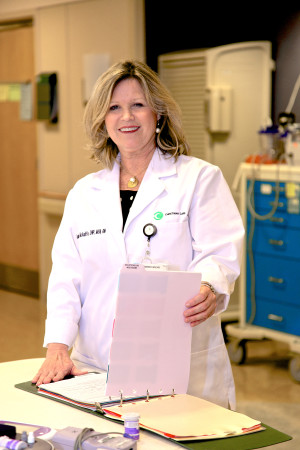A new technology-driven capacity-management system harnesses the power of the electronic medical record to streamline the bed-request process, ensuring that patients are efficiently admitted to the most appropriate hospital bed for their unique care needs.
Known as CareAware, the customized enterprise platform synchronizes the bed control, patient transport, bed turnover and discharge processes to increase the efficiency, quality and safety of care, ultimately reducing length of stay and lowering cost.
The right bed, the first time
According to Michelle Wheeler, BSN, MS, RN, operations director, Patient Access and Flow, from the Capacity Management System steer group, the new capacity-management system automatically alerts the nursing coordinator of an admission or transfer to a more appropriate level of care as soon as an order is entered into the medical record. It also pulls specific clinical information about the patient into view so appropriate patient placement can follow.
“Our goal is to place the patient in the correct bed the first time,” she said. “The new patient-placement system offers much more information about the patient’s needs up-front, allowing the coordinators to succeed in that effort.”
Integrated platform
While most bed-management systems are separate platforms, Christiana Care’s new integrated system is uniquely tied in with the health system’s electronic medical record, Powerchart, as well as Soarian, First Net and the data warehouse. Clinical data and patient attributes are automatically available in the bed-management system, reducing the potential loss of data that comes from information being manually entered, retrieved or communicated via paper or telephone. Bed placement, patient escort and environmental services perspectives are interwoven, allowing the new integrated platform to streamline, automate and improve processes that increase efficiency, reduce costs, improve quality and decrease turnaround times.
Wheeler said the integration with transport and environmental services is “critical to improving the timeliness of patient flow through the organization.”
Maryanne Miller, project lead from Information Technology, also from the steer group, added that making information available sooner to staff on the receiving unit inherently improves both quality and safety of care.
“Timely, accurate clinical information right up-front to help the bed board make really informed decisions in patient placement based on care needs will be a tremendous asset to the system,” she said. “From an IT perspective, the platform behind this new capacity management system — and what it allows us to do in terms of efficiency and streamlining — is really exciting.”
The system mines indicators automatically populated in Powerchart records to flag special needs, such as those for isolation or bariatric equipment, to ensure placement not just to the first available bed, but to the most appropriate bed for optimal patient care. It’s an amazing evolution for those who may recall, just a few decades ago, when the bed board was actually just that — several large boards on wheels, roughly 20 feet wide, covered with pink and blue magnetic cards denoting bed availability by gender.
“This project will have a huge impact on making sure patients get to the right bed the first time, and has the potential to improve patient flow, patient satisfaction and timeliness of getting the patient upstairs from the ED to the most appropriate room,” said Timothy Shiuh, M.D., FACEP, assistant chief medical information officer and clinical leader of the capacity management system design team.
Smarter transformations

“By pushing information to the people who need it, the inpatient units are better prepared to receive the patient, and we, in the Emergency Department, will avoid crowding situations that stretch our resources and tax our ability to care for patients in a safe and timely manner,” said Linda Laskowski Jones, MS, APRN, ACNS-BC, CEN, FAWM, FAAN, vice president, Emergency & Trauma Services, co-sponsor for the CareAware project. “Patient flow equates to patient safety.”
Because transitions are the most vulnerable time in a patient’s acute hospital experience, Joanne McAuliffe, DNP, MSN/BA, BSN, RN, OCN, NEA-BC, vice president of Patient Care Services, Wilmington Hospital, sees the new capacity-management system as a sorely needed tool to transform care at the bedside, both today and in the future.
“We have people transitioning from one location to another all day long,” said McAuliffe. “This ‘smart’ platform will help us track the patient, tell us who the patient is in terms of his clinical needs, and allow us to watch his needs change.
“The information we need is front and center, helping to guide operations in real time. That’s a huge win for everyone, but especially in terms of patient care,” she said.
“We’re transforming the way we predict and focus on patients, both in our day-to-day operations and in the future,” she said. “The new capacity-management system integrates technology and transforms practice at any bedside, regardless of location,” she said. “It will also help us build a database to see our patient population from a data set — to determine the attributes we treat most frequently and where those people land within our hospital — and allow us to strategically forecast clinical needs, programs, staffing, skill sets and competencies.”

While all hospitals and health systems rely on some sort of bed-management system, none of the steering committee members are aware of any that match Christiana Care’s ability to use data attributes to predict patient needs for bed placements.
“We’re on the forefront because we have the right people thinking in the right direction,” said McAuliffe. “We are an organization that recognizes the need to be astute in daily operations, but also thinking way beyond what we’re doing today.
“This is not a software package we’ve purchased, but one we are building in a reciprocal partnership with our vendor,” she added. “We are influencing the model that will probably serve other hospitals and health systems as they launch their own efforts in the near future.”



